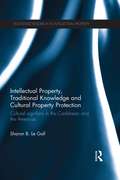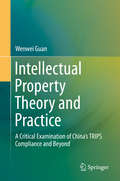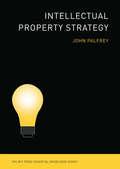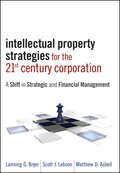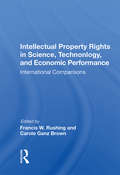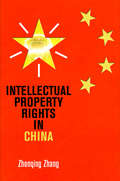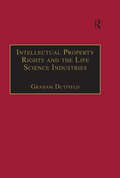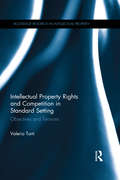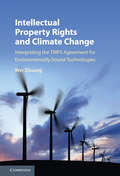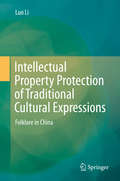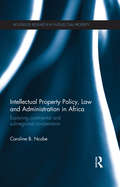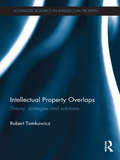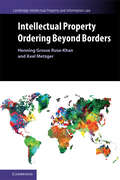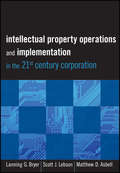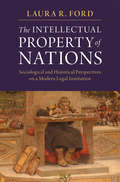- Table View
- List View
Intellectual Property, Traditional Knowledge and Cultural Property Protection: Cultural Signifiers in the Caribbean and the Americas (Routledge Research in Intellectual Property)
by Sharon B. Le GallInternational developments since the mid-1990s have signalled an awareness of the importance and validity of traditional knowledge and cultural property. The adoption of the Convention on Biological Diversity, and the establishment of the WIPO Intergovernmental Committee on Intellectual Property and Genetic Resources, Traditional Knowledge and Folklore demonstrate an emerging trend towards the recognition of the rights of communities and the importance of culture in shaping international law and policy. This book examines how developments to protect collectively held knowledge transpose to circumstances which may not meet the usually understood criteria of what is considered to be an indigenous or traditional group. This includes communally derived cultural products which have emerged out of communities and subsequently formed a part of the national or popular culture. The book considers the steel pan of Trinidad and Tobago, punta rock music from Belize, Brazilian capoeira, and the cajón of Peru as key cases studies of this. By exploring the impact of past and recent international developments to protect traditional knowledge, Sharon Le Gall highlights a category of cultural signifiers which lies outside the scope of intellectual property protection, as well as the protection proposed for traditional knowledge and advocated for intangible cultural property. The book proposes a reinterpretation of Joseph Raz’s interest theory of group rights in order to accommodate the rights advocated for collectively derived cultural signifiers on the basis of their value as symbols of identity. In doing so, Le Gall offers an original account of how those signifiers, which may not be described as exclusively ‘traditional’ or ‘indigenous’ and held in ways which are not ‘traditional’ or ‘customary’, may be accommodated in emerging traditional knowledge laws.
Intellectual Property Theory and Practice
by Wenwei GuanThis book explains China's intellectual property perspective in the context of European theories, through a critical examination of intellectual property theory and practice focused on China's compliance with the Agreement on Trade-Related Aspects of Intellectual Property Rights (TRIPS). The author's critical review of contemporary intellectual property philosophy suggests that justifying intellectual property protection through Locke or Hegel's property theories internalizes a theoretical paradox. "Professor Wenwei Guan's treatment of intellectual property law and practice in the PRC offers new perspectives that enrich an already active field of study . . . This book will be a useful contribution to academic and policy discourses examining conceptual and operational dimensions of China's intellectual property protection system and the broader process of China's international engagement. " - Dr. Pitman B. Potter, Professor of Law, University of British Columbia, Canada "Dr. Guan reminds us of the daunting challenge of the public-private divide in forming and reforming TRIPS regime; how this regime has failed to address development needs and public concerns in developing countries like China; and how TRIPS's 'birth defect' can be overcome and its evolution can be put back on the right track. " - Dr. Yahong Li, Associate Professor at Faculty of Law, Hong Kong University
Intellectual Property Strategy (The MIT Press Essential Knowledge series)
by John PalfreyHow a flexible and creative approach to intellectual property can help an organization accomplish goals ranging from building market share to expanding an industry.Most managers leave intellectual property issues to the legal department, unaware that an organization's intellectual property can help accomplish a range of management goals, from accessing new markets to improving existing products to generating new revenue streams. In this book, intellectual property expert and Harvard Law School professor John Palfrey offers a short briefing on intellectual property strategy for corporate managers and nonprofit administrators. Palfrey argues for strategies that go beyond the traditional highly restrictive “sword and shield” approach, suggesting that flexibility and creativity are essential to a profitable long-term intellectual property strategy—especially in an era of changing attitudes about media.Intellectual property, writes Palfrey, should be considered a key strategic asset class. Almost every organization has an intellectual property portfolio of some value and therefore the need for an intellectual property strategy. A brand, for example, is an important form of intellectual property, as is any information managed and produced by an organization. Palfrey identifies the essential areas of intellectual property—patent, copyright, trademark, and trade secret—and describes strategic approaches to each in a variety of organizational contexts, based on four basic steps.The most innovative organizations employ multiple intellectual property approaches, depending on the situation, asking hard, context-specific questions. By doing so, they achieve both short- and long-term benefits while positioning themselves for success in the global information economy.
Intellectual Property Strategy
by John PalfreyMost managers leave intellectual property issues to the legal department, unaware that an organization's intellectual property can help accomplish a range of management goals, from accessing new markets to improving existing products to generating new revenue streams. In this book, intellectual property expert and Harvard Law School professor John Palfrey offers a short briefing on intellectual property strategy for corporate managers and nonprofit administrators. Palfrey argues for strategies that go beyond the traditional highly restrictive "sword and shield" approach, suggesting that flexibility and creativity are essential to a profitable long-term intellectual property strategy--especially in an era of changing attitudes about media. Intellectual property, writes Palfrey, should be considered a key strategic asset class. Almost every organization has an intellectual property portfolio of some value and therefore the need for an intellectual property strategy. A brand, for example, is an important form of intellectual property, as is any information managed and produced by an organization. Palfrey identifies the essential areas of intellectual property--patent, copyright, trademark, and trade secret--and describes strategic approaches to each in a variety of organizational contexts, based on four basic steps. The most innovative organizations employ multiple intellectual property approaches, depending on the situation, asking hard, context-specific questions. By doing so, they achieve both short- and long-term benefits while positioning themselves for success in the global information economy.
Intellectual Property Strategies for the 21st Century Corporation
by Lanning G. Bryer Scott J. Lebson Matthew D. AsbellA practical approach to the modern management of intellectual property The world has changed significantly in the past decade, resulting in new behavior and practice related to the ownership and management of intellectual property. This book helps executives, attorneys, accountants, managers, owners, and others understand the legal, technological, economic, and cultural changes that have affected IP ownership and management. It provides case studies, practical examples and advice from seasoned and enduring professionals who have adopted new and streamlined methods and practices whether as in-house or outside counsel, or service providers. Provides a practical yet global approach to corporate IP management Serves as a resource for in-house and outside counsel, executives, managers, accountants, consultants and others at mid-size and large corporations Helps professionals navigate the numerous new challenges that have changed the ways in which intellectual property is obtained and managed Details the latest trends in valuation, exploitation, and protection of intellectual property Extensive coverage of the legal, financial, accounting and general business aspects of intellectual property The combined expertise of lawyers, accountants, economists and other business professionals Timely and relevant in view of the global economic recession amidst rampant technological development, this book offers new solutions, practices, policies and strategies as a result of changes in economies and markets, laws, globalization, environment, and public perception.
Intellectual Property Rights Management
by Lars Alkaersig Karin Beukel Toke ReichsteinIntellectual Property Rights Management explores how the entire toolbox of intellectual property (IP) protection and management are successfully combined and how firms generate value from IP. In particular, this book provides a framework of archetypes which firms will be able to self-identify with and which will allow companies to focus on the IP and IP Management issues most relevant to them. By doing so, the authors offer further insights as to the use of IP and IP management practices across firms. By looking at empirical data covering the population of firms, the findings not only pertain to large organization but also reflect the practices and operations that reside in SMEs. This volume also utilizes labor market and firm data to determine whether there is a definitive relationship between IP and economic performance on the firm level.
Intellectual Property Rights In Science, Technology, And Economic Performance: International Comparisons
by Francis W. Rushing Carole Ganz BrownThis book discusses the economic, political, legal, and social concerns of the world's governments on intellectual property rights. It analyzes the systems of both developed and developing economies and draws a clear picture of the status of intellectual property regimes around the world.
Intellectual Property Rights in Pharmaceutical Test Data: Origins, Globalisation and Impact
by Adam BuickThis book considers the intellectual property protection of clinical test data that has been submitted to governments, in particular through test data exclusivity rights. It focuses on how these intellectual property rights first emerged in the early 1980s, how they have globalised over the past four decades, and what impact they have had upon access to medicine. This book makes a number of significant and original contributions to the literature around the protection of submitted test data. First, the book draws upon the theory of regulatory globalisation to provide an explanation of how intellectual property rights in submitted pharmaceutical test data have become nearly ubiquitous in the legal systems of most major economies. Second, through a comprehensive analysis and synthesis of provisions on the protection of submitted test data in free trade agreements, as well as a comparison of a range of national approaches to the protection of submitted test data, it reveals the broader global regulatory pattern that has given rise to these intellectual property rights. Third, by analysing data on drug approvals in the US, it provides an empirical insight into the impact of test data exclusivity in national pharmaceutical markets. Fourth, the book covers a number of developments regarding test data exclusivity that have occurred as a result of responses to the COVID-19 pandemic, both at the national level as well as at the World Trade Organisation (WTO). This book will appeal to academics researching the intersection of intellectual property and the life sciences, civil society activists working to promote access to medicines, and students (particularly those at the post-graduate level) studying the relationship between intellectual property and medicine.
Intellectual Property Rights in China
by Andy Scott Sam Woollard Chris Devonshire-EllisThis Guide is a detailed overview of all aspects of IPR and protection in China. Produced in association with AWS, the Austrian Federal Bank's specialist IPR unit based in Shanghai, this is an essential work for any businessman trading with or conducting business in China. From covering protocol for dealing with Trade Fairs, to the application processes for trademarks, patents, copyright and licensing, as well as dealing with infringements and enforcement,this guide is a practical reference for any businessman with concerned with their IPR in China.
Intellectual Property Rights in China
by Zhenqing ZhangOver the past three decades, China has transformed itself from a stagnant, inward, centrally planned economy into an animated, outward-looking, decentralized market economy. Its rapid growth and trade surpluses have caused uneasiness in Western governments, which perceive this growth to be a result of China's rejection of international protocols that protect intellectual property and its widespread theft and replication of Western technology and products. China's major trading partners, particularly the United States, persistently criticize China for delivering, at best, half-hearted enforcement of intellectual property rights (IPR) norms. Despite these criticisms, Zhenqing Zhang argues that China does respect international intellectual property rights, but only in certain cases. In Intellectual Property Rights in China, Zhang addresses the variation in the effectiveness of China's IPR policy and explains the mechanisms for the uneven compliance with global IPR norms.Covering the areas of patent, copyright, and trademark, Zhang chronicles how Chinese IPR policy has evolved within the legacy of a planned economy and an immature market mechanism. In this environment, compliance with IPR norms is the result of balancing two factors: the need for short-term economic gains that depend on violating others' IPR and the aspirations for long-term sustained growth that requires respecting others' IPR. In case studies grounded in theoretical analysis as well as interviews and fieldwork, Zhang demonstrates how advocates for IPR, typically cutting-edge Chinese companies and foreign IPR holders, can be strong enough to persuade government officials to comply with IPR norms to achieve the country's long-term economic development goals. Conversely, he reveals the ways in which local governments protect IPR infringers because of their own political interests in raising tax revenues and creating jobs.
Intellectual Property Rights, Copynorm and the Fashion Industry: A Comparative Analysis
by Marlena JankowskaThis book traces the development of the fashion industry, providing insight into the business and, in particular, its interrelations with copyright law. The book explores how the greatest haute couture fashion designers also had a sense for business and that their attention to copyright was one of the weapons in protecting their market position. The work also confronts the peculiarities of the fashion industry as a means of demonstrating the importance of intellectual property protection while pointing out the many challenges involved. A central aim is to provide a copyrightability test for fashion goods based on detailed analysis of the legal regulations in the USA and EU countries, specifically Italy, France, the Netherlands, Germany and Poland. The book will be of interest to researchers and academics working in the areas of Intellectual Property Law, Copyright Law, Business Law, Fashion Law and Design.
Intellectual Property Rights and the Life Science Industries: A Twentieth Century History (Globalization and Law)
by Graham DutfieldThis book analyses the history of the international patent regime and the life science industries, both of which can be traced back to the late 19th century. The development of patent law is inextricably linked to expanding capacities to elucidate, manipulate and commercially exploit the molecular properties of micro-organisms, plants, animals and other organic raw materials. The story of the life science industries begins with the European synthetic dyestuff firms and culminates in present-day conglomerates like Aventis, Novartis and Pharmacia. Throughout the last century, chemical, pharmaceutical, seed and biotechnology firms were actively involved in reforming patent law and plant variety rights. The major beneficiaries have been the largest firms whose market dominance and influence over peoples' lives - aided by friendly intellectual property laws - has never been greater. This sparkling and stimulating book reveals the key repercussions caused by the expansion of life science industries for issues of international equity, public health, food security and biological diversity.
Intellectual Property Rights and Food Security
by Michael BlakeneyAt the time of the first World Food Summit in 1996 it was estimated that more than 800 million people did not have enough food to meet their basic nutritional needs. The steep rise in global food prices has exacerbated the situation, causing the 2008 G8 Hokkaido Toyako Summit to issue a Statement on Food Security which expressed concern that global food security was under a severe threat. The root cause of food insecurity is poverty. Trade liberalization is part of the long-term solution, as are improvements in agricultural productivity. This book examines the contribution which intellectual property rights can make in the struggle for food security in developing countries.
Intellectual Property Rights and Emerging Technology: 3D Printing in China
by Hing Kai Chan Hui Leng Choo Onyeka Osuji James Griffin3D printing poses many challenges to the traditional law of intellectual property (IP). This book develops a technical method to help overcome some of these legal challenges and difficulties. This is a collection of materials from empirical interviews, workshops and publications that have been carried out in one of the world's leading research projects into the legal impact of 3D printing. The project was designed to establish what legal challenges 3D printing companies thought they faced, and having done that, to establish a technical framework for a solution.
Intellectual Property Rights and Competition in Standard Setting: Objectives and tensions (Routledge Research in Intellectual Property)
by Valerio TortiCompetition and intellectual property rights (IPRs) are both necessary for a market to work efficiently and to promote consumer welfare. Properly applied, intellectual property rules define a legal framework which allows undertakings to profit from their inventions. This in turn encourages competition among firms and enhances dynamic efficiency, to the benefit of consumer welfare. Standard setting represents one of the fields where the interaction between competition law and IPRs clearly comes to light. The collaborative goal of standard setting organizations (SSOs) is to adopt and promote standards that either do not conflict with anyone’s right or, if they do, are developed under condition that patents are licensed under defined terms. This book examines the tension between IPRs and competition in the standard setting field which can arise when innovators over-exploit the rights they have been granted and hold up an entire industry. The book compares EU and U.S. jurisdictions with a particular focus on the IT and telecommunication sectors. It scrutinizes those practices which could harm standard setting and its goals, looking at misleading conducts by SSOs’ members which may lead to breach the EU and U.S. antitrust provisions on abuse of market power. Recent developments in EU and U.S. standard setting are analysed highlighting the differences in enforcement approaches. The book considers how the optimal balance between IPRs and industry standards can be struck, suggesting a policy model which takes into account both innovators’ interests and SSOs’ goals.
Intellectual Property Rights and Climate Change: Interpreting the TRIPS Agreement for Environmentally Sound Technologies
by Wei ZhuangAs the world confronts global warming, there is a growing consensus that the TRIPS Agreement could be a more effective instrument for mitigating climate change. In this innovative work, Wei Zhuang systematically examines the contextual elements that can be used in the interpretation of the TRIPS Agreement with a view to enhancing innovation and transfer of environmentally sound technologies. Zhuang proposes a balanced and pro-competitive interpretation that could be pursued by policy makers and negotiators. This comprehensive, multidisciplinary study will help academics and policymakers improve their understanding of the contemporary international legal regimes governing intellectual property rights and innovation and transfer of environmentally sound technologies. It also offers practical guidance for further developing a legal system capable of responding to the challenges posed by climate change.
Intellectual Property Rights and ASEAN Development in the Digital Age (Routledge-ERIA Studies in Development Economics)
by Lurong Chen Fukunari KimuraThe trade-investment-service-intellectual property (IP) nexus remains at the heart of economic development and the main features of which are global value chains (GVCs) and digitalisation. The protection of intellectual property rights (IPR) has become a critical issue not only for advanced economies but also for emerging markets. This edited volume contributes to the debates on IPR protection and economic development from the perspective of Association of Southeast Asian Nations (ASEAN) member states. The book provides insights into the mechanism and evidence on how effective IPR protection will increase economic and social welfare via promoting innovation activities and providing incentives to diffuse knowledge and transfer technologies. Written by economists and lawyers from the region, these experts share their latest findings and thoughts on how countries in Southeast Asia have been progressively improving IPR protection and increasing the interoperability of different IPR regimes through regional cooperation to facilitate business operations in the context of digital transformation.
Intellectual Property Protection of Traditional Cultural Expressions
by Luo LiThe work reviews issues concerning the protection of folklore through the intellectual property legal system, then explores two main issues in the protection of Chinese folklore. The first issue is the influence of Chinese traditional culture on the Chinese intellectual property legal system and Chinese society. The second concerns the deficiencies of the Chinese intellectual property system with regard to folklore. Both issues are examined through a survey on the weak public recognition of intellectual property law and folklore in Chinese society. The book also reveals the practical issues that have arisen in Southwest China through case studies. After analysing these issues, the work designs a model law specifically for folklore and also provides suggestions for how the current intellectual property legal system could establish a comprehensive legal protection system for folklore. Furthermore, the work shows that its proposed model law is effective in practice by resolving the issues in the case studies presented.
Intellectual Property Protection for Plant Related Innovation: Fit for Future? (Law for Professionals)
by Michael Andreas KockThe book reviews the history, present, and likely future of intellectual property for plant-related inventions. It describes “what works” and “what does not work” in the current situation and analyzes whether the current intellectual property framework will be able to cope with the rise of genome editing/new breeding technologies (especially CRISPR Cas). Based on trend data, the analysis shows that the current system, including stakeholder initiatives, will most likely not be able to adapt to the technology change. It then evaluates different options for legislators to respond and proposes in detail a new holistic IP system which merges elements of the patent and the plant variety protection system into one new system.
Intellectual Property Protection for AI-generated Creations: Europe, United States, Australia and Japan
by Ana RamalhoThis book explores the intersection between artificial intelligence and two intellectual property rights: copyright and patents. The increasing use of artificial intelligence for generating creative and innovative output has an impact on copyright and patent laws around the world. The book aims to map and analyse that impact. The author considers how artificial intelligence systems may aid, or in some cases substitute for, human creators and inventors in the creative process. It is from this angle that the copyright and patent regimes in four jurisdictions (Europe, the United States, Australia and Japan) are investigated in depth. The author describes how these jurisdictions look at works and inventions generated through a process where artificial intelligence is present or prevalent, and examines how copyright and patent regimes should adapt to the reality of artificially intelligent creators and inventors.As the use of artificial intelligence to generate creative and innovative products becomes more common, this book will be a valuable resource to researchers, academics and policy makers alike.
Intellectual Property Policy, Law and Administration in Africa: Exploring Continental and Sub-regional Co-operation (Routledge Research in Intellectual Property)
by Caroline B. NcubeThis book examines the harmonisation of Intellectual Property (IP) policy, law and administration in Africa. Two recent developments have brought this topic to the fore. The first is the escalation of long-standing efforts to establish a Pan-African Intellectual Property Organisation (PAIPO), a continental initiative. The second is the current sub-regional attempt to operationalise the IP provisions of the Southern African Development Community (SADC)’s Protocol on Trade (articles 9b and 24) and its Protocol on Science, Technology and Innovation (article 2m). Intellectual Property Policy, Law and Administration in Africa discusses the viability of such initiatives with particular reference to the current socio-economic status of Africa’s nations. With a view to contributing to future developments in Africa at both a continental and sub-regional level, the author considers this issue through the lens of advancing the public interest in IP. Ncube argues that harmonisation initiatives ought to be crafted in a way that is supportive of the development aspirations of African states. Consequently, she urges due consideration of individual states’ unique conditions and aspirations in any harmonisation venture, a necessity outlined in article 7 of the Agreement on Trade Related Aspects of Intellectual Property Rights. This book will be of great relevance to scholars and policy makers with an interest in IP law and African law in general.
Intellectual Property Overlaps: Theory, Strategies, and Solutions (Routledge Research in Intellectual Property)
by Robert TomkowiczIntellectual property rights and their overlaps are considered in light of rights purposes, relying on the concept of a balance of rights as the measuring rod for assessment of the consequences resulting from the exercise of overlapping rights. Identifying the complex interface between different types of intellectual property rights, this book discusses the use of these rights and their effect on a diverse group of stakeholders, from individual users of e-books to large corporations operating search engines on the internet.The book suggests solutions to potentially objectionable uses of overlapping rights in an attempt to provide judiciary and law practitioners with an analytical framework for resolving disputes of overlaps in the intellectual property system. In doing so, the author investigates how use of intellectual property rights associated with one segment of the system can affect the carefully crafted balance of rights held by various stakeholders in an overlapping segment. In particular, the book suggests that a properly construed doctrine of misuse of intellectual property rights would provide an adequate response to the challenge posed by improper use of overlapping intellectual propertyrights.This book is of particular interest to law practitioners, managers in advanced technology and media industries, academics, and university students who work with or analyze intellectual property and new technologies.
Intellectual Property Ordering beyond Borders (Cambridge Intellectual Property and Information Law)
by Ruse-Khan, Henning Grosse Axel MetzgerDuring the past century, intellectual property (IP) law has expanded within and beyond national borders. The field of IP law was once a niche area concerning authors, inventors, and trademark owners. Today, IP law acts as a complex regime of instruments, institutions, and actors that negotiate overlapping, diverging, and occasionally competing public policies on a global scale. As IP continues to expand beyond borders, the instruments and tools utilised for its global protection rely on public international law as the common denominator and unifying frame. Intellectual Property Ordering Beyond Borders provides an evaluation of the most pertinent public international law questions raised by this multidimensional expansion. This comprehensive and far-reaching volume tackles problems such as generalist approaches under the law of treaties; custom and general principles; interfaces between IP and other normative orders, such as trade and investment; and interdisciplinary accounts from the economic, political, and social science perspectives. This title is also available as open access on Cambridge Core.
Intellectual Property Operations and Implementation in the 21st Century Corporation
by Lanning G. Bryer Scott J. Lebson Matthew D. AsbellA practical approach to corporate IP operations and implementation Intellectual Property Operations and Implementation helps executives, attorneys, accountants, managers, and owners, understand the legal, technological, economic, and cultural changes that have affected corporate IP ownership and management. Page by page, it provides practical examples and advice from seasoned and enduring professionals who have adopted new and streamlined methods and practices whether as in-house or outside counsel, or service providers. Timely and relevant in view of the substantially global economic recession amidst rampant technological development and the resulting changes in law, practice, and culture Examines the decision making processes, activities, and changes of significant corporate intellectual property owners in today's new economy Important and timely, this book provides a global approach to corporate IP management.
The Intellectual Property of Nations: Sociological and Historical Perspectives on a Modern Legal Institution
by Laura R. FordDrawing on macro-historical sociological theories, this book traces the development of intellectual property as a new type of legal property in the modern nation-state system. In its current form, intellectual property is considered part of an infrastructure of state power that incentivizes innovation, creativity, and scientific development, all engines of economic growth. To show how this infrastructure of power emerged, Laura Ford follows macro-historical social theorists, including Michael Mann and Max Weber, back to antiquity, revealing that legal instruments very similar to modern intellectual property have existed for a long time and have also been deployed for similar purposes. Using comparative and historical evidence, this groundbreaking work reflects on the role of intellectual property in our contemporary political communities and societies; on the close relationship between law and religion; and on the extent to which law's obliging force depends on ancient, written traditions.
